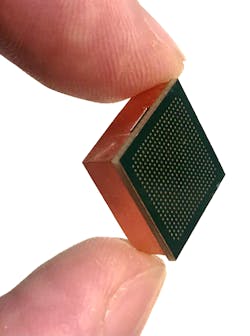Startup Nubis Communications announces XT1600 optical interconnect engine as first product
Startup Nubis Communications, Inc. has emerged from stealth mode with an optical interconnect technology for high-performance ASICs that leverages the chip’s internal copper-centric SerDes to directly drive optical interconnect. The company’s first product is the XT1600 optical engine, which offers 1.6 Tbps optical transmit and 1.6 Tbps optical receive carried over 16 fiber pairs.
The XT1600 is based on a building block that comprises a 16x112-Gbps (full duplex) silicon photonics device with integrated modulator drivers and transimpedance amplifiers. The 2D-tileable optical engine is designed to support more than 500 Gbps per millimeter of full-duplex edge I/O with a density that is pitch-matched to the bandwidth density of current ASIC SerDes. The 7-mm-square building block consumes less than 4 pJ per bit, according to Karen Liu, senior director of product management at the company. The company leverages a patented fiber array technology to support the 16 fiber pairs, which leave the device from its top.
The key differentiator is the ability to leverage the LR SerDes generally already aboard today’s high-performance ASICs to directly drive the optical interconnect engine. “You’re already paying for the SerDes – you may as well use it,” she told Lightwave. The direct-drive approach obviates the need for DSPs and related functions onboard the engine and drives down power consumption and cost. Depending on the size and requirements of the ASIC, multiple interconnect engines could be employed – including multiple rows of them, Liu said. The current version of the engine supports 100G per lane but 200G capability is on the roadmap.
The 15x15x5-nm XT1600 is the first of what promises to be several products and use cases the optical interconnect engine will support. Its 16 fiber pairs enable full fan-out and can be customized as 16 independent 100-Gbps full-duplex channels, four separate 400-Gbps full-duplex channels, or two 800-Gbps full-duplex channels, all in DR format and all via unretimed direct-drive operation. Liu said that initial interest is coming from companies looking to support next-generation AI/ML requirements, possibly in a near-packaged optics scenario paired with an external laser. The XT1600 is sampling now to multiple customers who reside in different parts of the AI/ML ecosystem, according to Liu. She anticipates the XT1600 will be ready for production early next year.
Meanwhile, Nubis envisions the platform enabling devices for a wider range of applications, including being paired with a DSP for active optical cable/transceiver applications. Liu said the company also foresees developing a version that will enable co-packaged optics. Liu added that NubisSim, a simulator that models the high-speed electro-optical data path from the transmitting host SerDes through packaging and optics and on to the receiving host Serdes that the company originally developed for internal use, is drawing interest from potential customers as a design tool.
Well-known founder
Peter Winzer, former head of Bell Labs’ fiber-optic transmission research, founded Nubis Communications in 2020 and serves as its CTO. Dan Harding, previously vice president of marketing at Broadcom, is CEO. Nubis has raised more than $40 million from Matrix Partners as well as investors Launch Capital, imec.xpand, Weili Dai and Sehat Sutardja, Comerica Technology and Life Sciences fund, and others.
“Our solution is optimized to work with modern SerDes, not only pitch matching to their edge I/O density but meshing with their capabilities for power-efficient direct-drive,” said Winzer via a press release. “The result is that AI accelerators or similar large ASICs can achieve full bandwidth connectivity within the data center at a fraction of the power compared to traditional optical solutions. Further, our approach lends itself well to novel emerging box architectures as well as to native chiplet implementations for even tighter integration in the future.”
"AI workloads often double in 4-5 months,” added Yong Kim, corporate fellow at Tenstorrent, Inc., a company developing optimized computers for AI, via the same release. “The only way to support that growth is through more processors and more interconnect. Only optics can scale spatially to support the AI growth at data center distances as they come, but the solution must have radically better cost, density, service reliability, and power consumption over existing optics. The Nubis technology is a major step toward meeting all these targets."
For related articles, visit the Optical Technologies Topic Center.
For more information on optical components and suppliers, visit the Lightwave Buyer’s Guide.
To stay abreast of optical communications technology, subscribe to Lightwave’s Enabling Technologies Newsletter.
About the Author

Stephen Hardy
Editorial Director and Associate Publisher, Lightwave
Stephen Hardy is editorial director and associate publisher of Lightwave and Broadband Technology Report, part of the Lighting & Technology Group at Endeavor Business Media. Stephen is responsible for establishing and executing editorial strategy across the both brands’ websites, email newsletters, events, and other information products. He has covered the fiber-optics space for more than 20 years, and communications and technology for more than 35 years. During his tenure, Lightwave has received awards from Folio: and the American Society of Business Press Editors (ASBPE) for editorial excellence. Prior to joining Lightwave in 1997, Stephen worked for Telecommunications magazine and the Journal of Electronic Defense.
Stephen has moderated panels at numerous events, including the Optica Executive Forum, ECOC, and SCTE Cable-Tec Expo. He also is program director for the Lightwave Innovation Reviews and the Diamond Technology Reviews.
He has written numerous articles in all aspects of optical communications and fiber-optic networks, including fiber to the home (FTTH), PON, optical components, DWDM, fiber cables, packet optical transport, optical transceivers, lasers, fiber optic testing, and more.
You can connect with Stephen on LinkedIn as well as Twitter.
